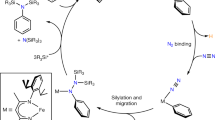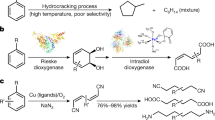Abstract
The cleavage of carbon−carbon (C−C) bonds by transition metals is of great interest, especially as this transformation can be used to produce fuels and other industrially important chemicals from natural resources such as petroleum and biomass. Carbon−carbon bonds are quite stable and are consequently unreactive under many reaction conditions. In the industrial naphtha hydrocracking process, the aromatic carbon skeleton of benzene can be transformed to methylcyclopentane and acyclic saturated hydrocarbons through C−C bond cleavage and rearrangement on the surfaces of solid catalysts1,2,3,4,5,6. However, these chemical transformations usually require high temperatures and are fairly non-selective. Microorganisms can degrade aromatic compounds under ambient conditions, but the mechanistic details are not known and are difficult to mimic7. Several transition metal complexes have been reported to cleave C−C bonds in a selective fashion in special circumstances, such as relief of ring strain, formation of an aromatic system, chelation-assisted cyclometallation and β-carbon elimination8,9,10,11,12,13,14,15. However, the cleavage of benzene by a transition metal complex has not been reported16,17,18,19. Here we report the C−C bond cleavage and rearrangement of benzene by a trinuclear titanium polyhydride complex. The benzene ring is transformed sequentially to a methylcyclopentenyl and a 2-methylpentenyl species through the cleavage of the aromatic carbon skeleton at the multi-titanium sites. Our results suggest that multinuclear titanium hydrides could serve as a unique platform for the activation of aromatic molecules, and may facilitate the design of new catalysts for the transformation of inactive aromatics.
This is a preview of subscription content, access via your institution
Access options
Subscribe to this journal
Receive 51 print issues and online access
$199.00 per year
only $3.90 per issue
Buy this article
- Purchase on Springer Link
- Instant access to full article PDF
Prices may be subject to local taxes which are calculated during checkout


Similar content being viewed by others
Accession codes
Data deposits
X-ray crystallographic coordinates of 2, 4, 5 and 6 have been deposited at the Cambridge Crystallographic Database under accession numbers 981670–981673.
References
Jones, D. S. J. & Pujadó, P. R. Handbook of Petroleum Processing (Springer, 2006)
Weitkamp, J. Handbook of Heterogeneous Catalysis Vol. 1, 2nd edn (eds Ertl, G., Knözinger, H., Schüth, F. & Weitkamp, J. ) Ch. 14.2 (Wiley-VCH, 2008)
Watanabe, R., Suzuki, T. & Okuhara, T. Skeletal isomerization of alkanes and hydroisomerization of benzene over solid strong acids and their bifunctional catalysts. Catal. Today 66, 123–130 (2001)
McVicker, G. B. et al. Selective ring opening of naphthenic molecules. J. Catal. 210, 137–148 (2002)
Benitez, V. M., Grau, J. M., Yori, J. C., Pieck, C. L. & Vera, C. R. Hydroisomerization of benzene-containing paraffinic feedstocks over Pt/WO3-ZrO2 catalysts. Energy Fuels 20, 1791–1798 (2006)
Kazakov, M. O. et al. Hydroisomerization of benzene-containing gasoline fractions on a Pt/SO42−-ZrO2-Al2O3 catalyst: I. Effect of chemical composition on the phase state and texture characteristics of SO42−-ZrO2-Al2O3 supports. Kinet. Catal. 51, 438–443 (2010)
Bugg, T. D. H. & Winfield, C. J. Enzymatic cleavage of aromatic rings: mechanistic aspects of the catechol dioxygenases and later enzymes of bacterial oxidative cleavage pathways. Nat. Prod. Rep. 15, 513–530 (1998)
Bishop, K. C. Transition metal catalysed rearrangements of small ring organic molecules. Chem. Rev. 76, 461–486 (1976)
Crabtree, R. H. The organometallic chemistry of alkanes. Chem. Rev. 85, 245–269 (1985)
Jones, W. D. The fall of the C–C bond. Nature 364, 676–677 (1993)
Rybtchinski, B. & Milstein, D. Metal insertion into C–C bonds in solution. Angew. Chem. Int. Ed. 38, 870–883 (1999)
Jun, C. Transition metal-catalysed carbon–carbon bond activation. Chem. Soc. Rev. 33, 610–618 (2004)
Murakami, M. & Matsuda, T. Metal-catalysed cleavage of carbon-carbon bonds. Chem. Commun. 47, 1100–1105 (2011)
Ruhland, K. Transition-metal-mediated cleavage and activation of C–C single bonds. Eur. J. Org. Chem. 2012, 2683–2706 (2012)
Takao, T. & Suzuki, H. Skeletal rearrangement of hydrocarbyl ligands on a triruthenium core induced by chemical oxidation. Coord. Chem. Rev. 256, 695–708 (2012)
Sattler, A. & Parkin, G. Cleaving carbon–carbon bonds by inserting tungsten into unstrained aromatic rings. Nature 463, 523–526 (2010)
Kira, M., Ishida, S., Iwamoto, T. & Kabuto, C. Excited-state reactions of an isolable silylene with aromatic compounds. J. Am. Chem. Soc. 124, 3830–3831 (2002)
Ellis, D., McKay, D., Macgregor, S. A., Rosair, G. M. & Welch, A. J. Room-temperature C–C bond cleavage of an arene by a metallacarborane. Angew. Chem. Int. Ed. 49, 4943–4945 (2010)
Szyszko, B., Latos-Grażyński, L. & Szterenberg, L. A facile palladium-mediated contraction of benzene to cyclopentadiene: transformations of palladium(II) p-benziporphyrin. Angew. Chem. Int. Ed. 50, 6587–6591 (2011)
Van Hove, M. A., Lin, R. F. & Somorjai, G. A. Surface structure of coadsorbed benzene and carbon monoxide on the rhodium(III) single crystal analysed with low energy electron diffraction intensities. J. Am. Chem. Soc. 108, 2532–2537 (1986)
Dyson, P. J. Arene hydrogenation by homogeneous catalysts: fact or fiction? Dalton Trans. 2964–2974 (2003)
Tardif, O., Hashizume, D. & Hou, Z. Hydrogenation of carbon dioxide and aryl isocyanates by a tetranuclear tetrahydrido yttrium complex. isolation, structures, and CO2 insertion reactions of methylene diolate and μ3-oxo yttrium complexes. J. Am. Chem. Soc. 126, 8080–8081 (2004)
Shima, T. & Hou, Z. Hydrogenation of carbon monoxide by tetranuclear rare earth metal polyhydrido complexes. selective formation of ethylene and isolation of well-defined polyoxo rare earth metal clusters. J. Am. Chem. Soc. 128, 8124–8125 (2006)
Nishiura, M. & Hou, Z. Novel polymerization catalysts and hydride clusters from rare-earth metal dialkyls. Nature Chem. 2, 257–268 (2010)
Shima, T. et al. Molecular heterometallic hydride clusters composed of rare-earth and d-transition metals. Nature Chem. 3, 814–820 (2011)
Shima, T. et al. Dinitrogen cleavage and hydrogenation by a trinuclear titanium polyhydride complex. Science 340, 1549–1552 (2013)
Brookhart, M. & Green, M. L. H. Carbon-hydrogen-transition metal bonds. J. Organomet. Chem. 250, 395–408 (1983)
Suzuki, H., Takaya, Y., Takemori, T. & Tanaka, M. Selective carbon-carbon bond cleavage of cyclopentadiene on a trinuclear ruthenium pentahydride complex. J. Am. Chem. Soc. 116, 10779–10780 (1994)
Brown, D. B. et al. Cluster-mediated ring contraction: synthesis and characterisation of [Ru6(μ3-H)(μ4-η2-CO)2(CO)13(η5-C5H4Me)] and [Ru6(μ3-H)(μ4-η2-CO)2(CO)13(η5-C5H3C3H6)]. J. Chem. Soc. Dalton Trans. 1909–1914 (1997)
Takao, T. et al. Synthesis and property of diruthenium complexes containing bridging cyclic diene ligands and the reaction of diruthenium tetrahydrido complex with benzene forming a μ-η2:η2-cyclohexadiene complex via partial hydrogenation on a Ru2 centre. Organometallics 30, 5057–5067 (2011)
Acknowledgements
This work was supported by a Grant-in-Aid for Young Scientists (B) (no. 26810041), a Grant-in-Aid for Scientific Research (C) (no. 26410082) and a Grant-in-Aid for Scientific Research (S) (no. 26220802) from JSPS, and an Incentive Research Grant from RIKEN. We thank J. Cheng for help with X-ray structure analyses, and A. Karube for conducting elemental analyses.
Author information
Authors and Affiliations
Contributions
Z.H., S.H. and T.S. had the idea for and designed the experiments. S.H. and T.S. conducted the experiments. Z.H. and S.H. wrote the manuscript. All authors participated in data analyses and discussions. Z.H. directed the project.
Corresponding author
Ethics declarations
Competing interests
The authors declare no competing financial interests.
Supplementary information
Supplementary Information
This file contains Supplementary text and Data, Supplementary Figures 1-49 and Supplementary References. (PDF 4916 kb)
PowerPoint slides
Rights and permissions
About this article
Cite this article
Hu, S., Shima, T. & Hou, Z. Carbon–carbon bond cleavage and rearrangement of benzene by a trinuclear titanium hydride. Nature 512, 413–415 (2014). https://doi.org/10.1038/nature13624
Received:
Accepted:
Published:
Issue Date:
DOI: https://doi.org/10.1038/nature13624
This article is cited by
-
Cleavage of non-polar C(sp2)‒C(sp2) bonds in cycloparaphenylenes via electric field-catalyzed electrophilic aromatic substitution
Nature Communications (2023)
-
Hydrogenomics: Efficient and Selective Hydrogenation of Stable Molecules Utilizing Three Aspects of Hydrogen
Catalysis Letters (2022)
-
Benzene rings broken for chemical synthesis
Nature (2021)
-
Zn-Nx sites on N-doped carbon for aerobic oxidative cleavage and esterification of C(CO)-C bonds
Nature Communications (2021)
-
Cleaving arene rings for acyclic alkenylnitrile synthesis
Nature (2021)
Comments
By submitting a comment you agree to abide by our Terms and Community Guidelines. If you find something abusive or that does not comply with our terms or guidelines please flag it as inappropriate.



